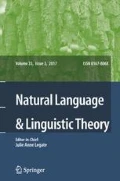Abstract
Emonds (1991) claims that many phenomena that I attribute to the effects of conceptual structure on syntax in Jackendoff (1987a) are more properly accounted for in terms of syntax alone. The present paper shows that Emonds has misconstrued the role intended for conceptual structure in the interface between language and cognition. It then specifies precisely where Emonds's approach to argument selection differs technically from mine, and shows that the technical differences favor my approach as further developed in Jackendoff (1990). Finally, an improved account of the semantic selection of oblique arguments is proposed, but it is shown that still not all syntactic argument selection can be eliminated from lexical entries of verbs.
Similar content being viewed by others
References
Baker, Mark: 1988,Incorporation: A Theory of Grammatical Function Changing, University of Chicago Press, Chicago. (Doctoral dissertation, 1985, MIT)
Bresnan, Joan and Jonni Kanerva: 1989, ‘Locative Inversion in Chicheŵa: A Case Study of Factorization in Grammar’,Linguistic Inquiry 20, 1–50.
Bresnan, Joan, and Lioba Moshi: 1990, ‘Object Asymmetries in Comparative Bantu Syntax’,Linguistic Inquiry 21, 147–185.
Carrier-Duncan, Jill: 1985, ‘Linking of Thematic Roles in Derivational Word Formation’,Linguistic Inquiry 16, 1–34.
Carrier, Jill and Janet Randall: 1992,From Conceptual Structure to Syntax: Projecting from Resultatives, Foris, Dordrecht.
Cheney, Dorothy and Robert Seyfarth: 1990,How Monkeys See the World, University of Chicago Press, Chicago.
Chomsky, Noam: 1957,Syntactic Structures, Mouton, The Hague.
Chomsky, Noam: 1965,Aspects of the Theory of Syntax, MIT Press, Cambridge, MA.
Chomsky, Noam: 1972,Studies on Semantics in Generative Grammar, Mouton, The Hague.
Chomsky, Noam: 1981,Lectures on Government and Binding, Foris, Dordrecht.
Culicover, Peter and Ray Jackendoff: (in preparation), ‘Something Else for the Binding Theory’.
Dowty, David: 1991, ‘Thematic Proto-Roles and Argument Selection’,Language 67, 547–619.
Emonds, Joseph E: 1991, ‘Subcategorization and Syntax-Based Theta-Role Assignment’,Natural Language and Linguistic Theory 9, 369–429.
Fillmore, Charles: 1968, ‘The Case for Case’, in E. Bach and R. Harms (eds.),Universals in Linguistic Theory, 1–90. Holt, Rinehart, and Winston, New York.
Fodor, Jerry: 1983,The Modularity of Mind, Bradford/MIT Press, Cambridge, MA.
Foley, William and Robert Van Valin: 1984,Functional Syntax and Universal Grammar, Cambridge University Press, Cambridge.
Goldberg, Adele: 1992, ‘The Semantics of the English Caused-Motion Construction’, CSLI Technical Report No. 163, Center for the Study of Language and Information, Stanford.
Grimshaw, Jane: 1979, ‘Complement Selection and the Lexicon’,Linguistic Inquiry 10, 279–325.
Grimshaw, Jane: 1987, ‘Psych Verbs and the Structure of Argument Structure’, Manuscript, Brandeis University.
Grimshaw, Jane: 1990,Argument Structure, MIT Press, Cambridge, MA.
Gruber, Jeffrey: 1965,Studies in Lexical Relations, Doctoral dissertation, MIT. Reprinted by Indiana University Linguistics Club, Bloomington, IN. Reprinted (1976) as part ofLexical Structures in Syntax and Semantics, North-Holland, Amsterdam.
Gruber, Jeffrey: 1991, ‘Proper Internal Projection of θ-Roles’, Manuscript, MIT.
Jackendoff, Ray: 1972,Semantic Interpretation in Generative Grammar, MIT Press, Cambridge, MA.
Jackendoff, Ray: 1983,Semantics and Cognition, MIT Press, Camridge, MA.
Jackendoff, Ray: 1987a, ‘The Status of Thematic Relations in Linguistic Theory’,Linguistic Inquiry 18, 369–411.
Jackendoff, Ray: 1987b,Consciousness and the Computational Mind, MIT Press, Cambridge, MA.
Jackendoff, Ray: 1990,Semantic Structures, MIT Press, Cambridge, MA.
Jackendoff, Ray: 1991, ‘Parts and Boundaries’,Cognition 41, 9–45.
Jackendoff, Ray: 1992, ‘Mme. Tussaud Meets the Binding Theory’,Natural Language and Linguistic Theory 10, 1–31.
Jackendoff, Ray and Barbara Landau: 1991, ‘Spatial Language and Spatial Cognition’, in D. J. Napoli and J. Kegl (eds.),Bridges Between Psychology and Language: A Swarthmore Festschrift for Lila Gleitman, pp. 144–169. Erlbaum, Hillsdale, NJ.
Köhler, Wolfgang: 1927,The Mentality of Apes. Vintage Books, New York.
Lakoff, George: 1987,Women, Fire, and Dangerous Things, University of Chicago Press, Chicago.
Langacker, Ronald: 1986,Foundations of Cognitive Grammar, Vol. 1, Stanford University Press, Stanford, CA.
McCawley, James D.: 1968, ‘Concerning the Base Component of a Transformational Grammar’,Foundations of Language 4, 243–269.
Miller, George and Philip Johnson-Laird: 1976,Language and Perception, Harvard University Press, Cambridge, MA.
Nikanne, Urpo: 1990,Zones and Tiers: A Study of Thematic Structure, Suomalaisen Kirjallisuuden Seura, Helsinki.
Parsons, Terence: 1991,Events in the Semantics of English: A Study in Subatomic Semantics, MIT Press, Cambridge, MA.
Pesetsky, David: 1982,Paths and Categories, Doctoral dissertation, MIT.
Pinker, Steven: 1989,Learnability and Cognition: The Acquisition of Argument Structure, Bradford/MIT Press, Cambridge, MA.
Pustejovsky, James: 1991, ‘The Syntax of Event Structure’,Cognition 41, 47–81.
Rappaport, M. and B. Levin: 1988, ‘What to Do with Theta-Roles’, in Wendy Wilkins, (ed.),Syntax and Semantics, Vol. 21: Thematic Relations, pp. 7–36. Academic Press, New York.
Ravin, Yael: 1990,Lexical Semantics without Thematic Roles, Clarendon Press/Oxford, New York.
Shieber, Stuart: 1986,An Introduction to Unification-Based Approaches to Grammar, Center for the Study of Language and Information, Stanford University, Stanford, CA.
Stowell, Tim: 1981,Origins of Phrase Structure, Doctoral dissertation, Cambridge, MA.
Tooby, John and Leda Cosmides: 1989, ‘Evolutionary Psychology and the Generation of Culture, Part I’,Ethology and Sociobiology 10, 29–49.
Williams, Edwin: 1984, ‘Grammatical Relations’,Linguistic Inquiry 15, 639–674.
Yip, Moira, Joan Maling and Ray Jackendoff: 1987, ‘Case in Tiers’,Language 63, 217–250.
Author information
Authors and Affiliations
Additional information
I am grateful to Jeffrey Gruber, Noam Chomsky, Fritz Newmeyer, and Joe Emonds for comments on an earlier version of this paper, and to Daniel Büring, Katharina Hartmann, Emile van der Zee, and Urpo Nikanne for valuable discussion of issues of lexical insertion. That does not mean they agree with what I have to say here, of course. This research was supported in part by NSF Grant IRI 90-46528 to Brandeis University.
Rights and permissions
About this article
Cite this article
Jackendoff, R. On the role of conceptual structure in argument selection: A reply to Emonds. Nat Lang Linguist Theory 11, 279–312 (1993). https://doi.org/10.1007/BF00992915
Received:
Revised:
Issue Date:
DOI: https://doi.org/10.1007/BF00992915




